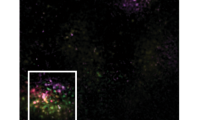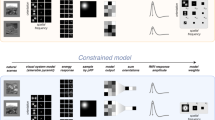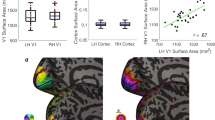Abstract
Visual area V4 in the macaque monkey is a cortical area that is strongly involved in color and shape perception. However, fundamental questions about V4 are still debated. V4 was initially characterized as a color-processing area, but subsequent studies revealed that it contains a diverse complement of cells, including those with preference for color, orientation, disparity and higher-order feature preferences. This has led to disputes and uncertainty about the role of V4 in vision. Using intrinsic signal optical imaging methods in awake, behaving monkeys, we found that different feature preferences are functionally organized in V4. Optical images revealed that regions with preferential response to color were largely separate from orientation-selective regions. Our results help to resolve long-standing controversies regarding functional diversity and retinotopy in V4 and indicate the presence of spatially biased distribution of featural representation in V4 in the ventral visual pathway.
This is a preview of subscription content, access via your institution
Access options
Subscribe to this journal
Receive 12 print issues and online access
$209.00 per year
only $17.42 per issue
Buy this article
- Purchase on Springer Link
- Instant access to full article PDF
Prices may be subject to local taxes which are calculated during checkout







Similar content being viewed by others
References
Livingstone, M.S. & Hubel, D.H. Anatomy and physiology of a color system in the primate visual cortex. J. Neurosci. 4, 309–356 (1984).
Hubel, D.H. & Livingstone, M.S. Segregation of form, color, and stereopsis in primate area 18. J. Neurosci. 7, 3378–3415 (1987).
Leventhal, A.G., Thompson, K.G., Liu, D., Zhou, Y. & Ault, S.J. Concomitant sensitivity to orientation, direction, and color of cells in layers 2, 3, and 4 of monkey striate cortex. J. Neurosci. 15, 1808–1818 (1995).
Levitt, J.B., Kiper, D.C. & Movshon, J.A. Receptive field and functional architecture of macaque V2. J. Neurophysiol. 71, 2517–2542 (1994).
Sincich, L.C. & Horton, J.C. The circuitry of V1 and V2: integration of color, form, and motion. Annu. Rev. Neurosci. 28, 303–326 (2005).
Zeki, S.M. Colour coding in rhesus monkey prestriate cortex. Brain Res. 53, 422–427 (1973).
Krüger, J. & Gouras, P. Spectral selectivity of cells and its dependence on slit length in monkey visual cortex. J. Neurophysiol. 43, 1055–1069 (1980).
Schein, S.J., Marrocco, R.T. & de Monasterio, F.M. Is there a high concentration of color-selective cells in area V4 of monkey visual cortex? J. Neurophysiol. 47, 193–213 (1982).
Tanaka, M., Weber, H. & Creutzfeldt, O.D. Visual properties and spatial distribution of neurones in the visual association area on the prelunate gyrus of the awake monkey. Exp. Brain Res. 65, 11–37 (1986).
Ghose, G.M. & Ts'o, D.Y. Form processing modules in primate area V4. J. Neurophysiol. 77, 2191–2196 (1997).
Maunsell, J.H. & Treue, S. Feature-based attention in visual cortex. Trends Neurosci. 29, 317–322 (2006).
Xiao, Y., Wang, Y. & Felleman, D.J. A spatially organized representation of colour in macaque cortical area V2. Nature 421, 535–539 (2003).
Vanzetta, I., Slovin, H., Omer, D.B. & Grinvald, A. Columnar resolution of blood volume and oximetry functional maps in the behaving monkey; implications for fMRI. Neuron 42, 843–854 (2004).
Lu, H.D. & Roe, A.W. Functional organization of color domains in V1 and V2 of macaque monkey revealed by optical imaging. Cereb. Cortex 18, 516–533 (2008).
Gattass, R., Sousa, A.P. & Gross, C.G. Visuotopic organization and extent of V3 and V4 of the macaque. J. Neurosci. 8, 1831–1845 (1988).
Roe, A.W. & Ts'o, D.Y. Visual topography in primate V2: multiple representation across functional stripes. J. Neurosci. 15, 3689–3715 (1995).
Hubel, D.H. & Wiesel, T.N. Sequence regularity and geometry of orientation columns in the monkey striate cortex. J. Comp. Neurol. 158, 267–293 (1974).
Bonhoeffer, T. & Grinvald, A. Iso-orientation domains in cat visual cortex are arranged in pinwheel-like patterns. Nature 353, 429–431 (1991).
Xiao, Y., Casti, A., Xiao, J. & Kaplan, E. Hue maps in primate striate cortex. Neuroimage 35, 771–786 (2007).
Kotake, Y., Morimoto, H., Okazaki, Y., Fujita, I. & Tamura, H. Organization of color-selective neurons in macaque visual area V4. J. Neurophysiol. 102, 15–27 (2009).
Wang, Y., Xiao, Y. & Felleman, D.J. V2 thin stripes contain spatially organized representations of achromatic luminance change. Cereb. Cortex 17, 116–129 (2007).
Dobkins, K.R., Thiele, A. & Albright, T.D. Comparison of red-green equiluminance points in humans and macaques: evidence for different L:M cone ratios between species. J. Opt. Soc. Am. A Opt. Image Sci. Vis. 17, 545–556 (2000).
Livingstone, M. & Hubel, D. Segregation of form, color, movement, and depth: anatomy, physiology, and perception. Science 240, 740–749 (1988).
Gallant, J.L., Braun, J. & Van Essen, D.C. Selectivity for polar, hyperbolic and Cartesian gratings in macaque visual cortex. Science 259, 100–103 (1993).
Pasupathy, A. & Connor, C.E. Responses to contour features in macaque area V4. J. Neurophysiol. 82, 2490–2502 (1999).
Kobatake, E. & Tanaka, K. Neuronal selectivities to complex object features in the ventral visual pathway of the macaque cerebral cortex. J. Neurophysiol. 71, 856–867 (1994).
Zeki, S. The distribution of wavelength and orientation selective cells in different areas of monkey visual cortex. Proc. R. Soc. Lond. B Biol. Sci. 217, 449–470 (1983).
Conway, B.R., Moeller, S. & Tsao, D.Y. Specialized color modules in macaque extrastriate cortex. Neuron 56, 560–573 (2007).
Zeki, S.M. Cortical projections from two prestriate areas in the monkey. Brain Res. 34, 19–35 (1971).
Stepniewska, I., Collins, C.E. & Kaas, J.H. Reappraisal of DL/V4 boundaries based on connectivity patterns of dorsolateral visual cortex in macaques. Cereb. Cortex 15, 809–822 (2005).
Xiao, Y., Zych, A. & Felleman, D.J. Segregation and convergence of functionally defined V2 thin stripe and interstripe compartment projections to area V4 of macaques. Cereb. Cortex 9, 792–804 (1999).
Xu, X. et al. Functional organization of visual cortex in the owl monkey. J. Neurosci. 24, 6237–6247 (2004).
Van Essen, D.C. & Zeki, S.M. The topographic organization of rhesus monkey prestriate cortex. J. Physiol. (Lond.) 277, 193–226 (1978).
Maguire, W.M. & Baizer, J.S. Visuotopic organization of the prelunate gyrus in rhesus monkey. J. Neurosci. 4, 1690–1704 (1984).
Fize, D. et al. The retinotopic organization of primate dorsal V4 and surrounding areas: a functional magnetic resonance imaging study in awake monkeys. J. Neurosci. 23, 7395–7406 (2003).
Hubel, D.H. & Wiesel, T.N. Functional architecture of macaque monkey visual cortex. Proc. R. Soc. Lond. B Biol. Sci. 198, 1–59 (1977).
Vanduffel, W., Tootell, R.B., Schoups, A.A. & Orban, G.A. The organization of orientation selectivity throughout macaque visual cortex. Cereb. Cortex 12, 647–662 (2002).
Tootell, R.B., Nelissen, K., Vanduffel, W. & Orban, G.A. Search for color 'center(s)' in macaque visual cortex. Cereb. Cortex 14, 353–363 (2004).
Desimone, R. & Schein, S.J. Visual properties of neurons in area V4 of the macaque: sensitivity to stimulus form. J. Neurophysiol. 57, 835–868 (1987).
Harada, T. et al. Distribution of colour-selective activity in the monkey inferior temporal cortex revealed by functional magnetic resonance imaging. Eur. J. Neurosci. 30, 1960–1970 (2009).
Moore, T. & Armstrong, K.M. Selective gating of visual signals by microstimulation of frontal cortex. Nature 421, 370–373 (2003).
Hayden, B.Y. & Gallant, J.L. Time course of attention reveals different mechanisms for spatial and feature-based attention in area V4. Neuron 47, 637–643 (2005).
Koida, K. & Komatsu, H. Effects of task demands on the responses of color-selective neurons in the inferior temporal cortex. Nat. Neurosci. 10, 108–116 (2007).
Chen, L.M. et al. A chamber and artificial dura method for long-term optical imaging in the monkey. J. Neurosci. Methods 113, 41–49 (2002).
Huettel, S.A., Song, A.W. & McCarthy, G. Functional Magnetic Resonance Imaging (Sinauer Associates, Sunderland, Massachusetts, 2004).
Bonhoeffer, T. & Grinvald, A. Optical imaging based on intrinsic signals: the methodology. in Brain Mapping: the Methods (eds. Toga, A.W. & Mazziotta, J.C.) 55–97 (Academic Press, New York, 1996).
Zhan, C.A. & Baker, C.L. Jr. Boundary cue invariance in cortical orientation maps. Cereb. Cortex 16, 896–906 (2006).
Acknowledgements
We thank J.H. Kaas and G. Chen for comments on the manuscript and Y. Chu for technical assistance. This work was supported by grants from the US National Institutes of Health, Vanderbilt Vision Research Center and Vanderbilt University Center for Integrative & Cognitive Neuroscience to A.W.R.
Author information
Authors and Affiliations
Contributions
H.T. and A.W.R. designed the experiments. H.T. performed the experiments and analyzed the data. H.L. assisted H.T. with experimental procedures. H.T. and A.W.R. discussed the results and wrote the paper.
Corresponding author
Ethics declarations
Competing interests
The authors declare no competing financial interests.
Supplementary information
Supplementary Text and Figures
Supplementary Figures 1–7, Supplementary Table 1 and Supplementary Note (PDF 2518 kb)
Rights and permissions
About this article
Cite this article
Tanigawa, H., Lu, H. & Roe, A. Functional organization for color and orientation in macaque V4. Nat Neurosci 13, 1542–1548 (2010). https://doi.org/10.1038/nn.2676
Received:
Accepted:
Published:
Issue Date:
DOI: https://doi.org/10.1038/nn.2676
This article is cited by
-
Feedforward attentional selection in sensory cortex
Nature Communications (2023)
-
Adaptive coding across visual features during free-viewing and fixation conditions
Nature Communications (2023)
-
Exploring the Brain-like Properties of Deep Neural Networks: A Neural Encoding Perspective
Machine Intelligence Research (2022)
-
Processing of visual statistics of naturalistic videos in macaque visual areas V1 and V4
Brain Structure and Function (2022)
-
Function-specific projections from V2 to V4 in macaques
Brain Structure and Function (2022)



